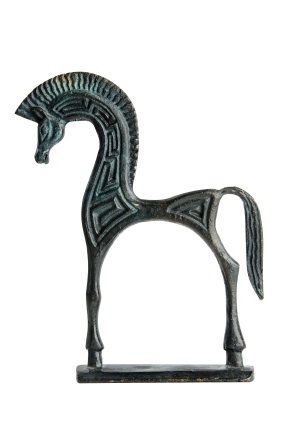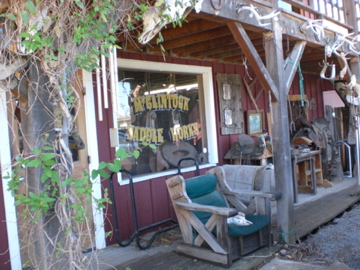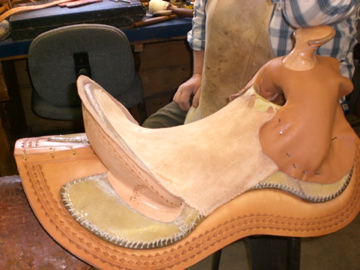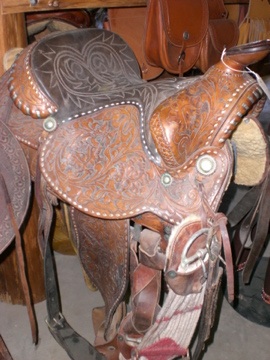
|
|
 |
||||||||||||||||||||
|
|
|||||||||||||||||||||
|
A Master Saddle Maker at Work Text and Photos by Jeannine Clark To catch a glimpse of the last Western frontier you need only travel to lower California,  where ranch families of old Spain can still be found living in the mountains of Baja - much as they have for the past 300 years. With no roads leading in, and rugged, rocky terrain to cross, the only way to get to this secluded community is on mule back. Vaqueros (or cowboys) still live there with their families, in partnership with the land, surviving the same way they have in the past: by trade and cooperation. Garry McClintock, master saddle maker and part-time historian, recently introduced me to the last Western frontier and the heart of the American cowboy. where ranch families of old Spain can still be found living in the mountains of Baja - much as they have for the past 300 years. With no roads leading in, and rugged, rocky terrain to cross, the only way to get to this secluded community is on mule back. Vaqueros (or cowboys) still live there with their families, in partnership with the land, surviving the same way they have in the past: by trade and cooperation. Garry McClintock, master saddle maker and part-time historian, recently introduced me to the last Western frontier and the heart of the American cowboy. McClintock began his history lesson with an explanation about the origins of the Western-style saddle: During the Spanish colonization of the Americas, Hernán Cortés brought cattle and horses to the U.S. via what is now Mexico. The first mission in San Diego, California brought about the need for mules and horses  in the area, and in order to control those herds, cowboys needed the right equipment - including a saddle made for more than just riding. Borrowing from its Spanish heritage, the Western saddle was designed in the 1500’s with a horn on top to hold the rope that cowboys could use to lasso wild horses and steers. (The horn is the most distinctive difference between Western and English saddles, and serves an important purpose in providing leverage for the cowboys; without it, many were hurt or thrown from horseback when wrangling cattle.) in the area, and in order to control those herds, cowboys needed the right equipment - including a saddle made for more than just riding. Borrowing from its Spanish heritage, the Western saddle was designed in the 1500’s with a horn on top to hold the rope that cowboys could use to lasso wild horses and steers. (The horn is the most distinctive difference between Western and English saddles, and serves an important purpose in providing leverage for the cowboys; without it, many were hurt or thrown from horseback when wrangling cattle.)The most predominant material in the making of a saddle is leather - a material that McClintock has been working with in one way or another for nearly 40 years. At age 19, a trip to Mexico changed the course of his life when he watched and learned how to treat, cut and design leather goods. After a lot of practice and a strong desire to work for himself, McClintock dropped out of college and started making belts and selling them store-to-store. He was so successful, he hired a salesman to help him expand. JC Penney’s liked his craftsmanship so much that the major department store chain ordered dozens of belts for all of their stores, and a $50,000-a-month business was born. A native Californian with a passion for horses, McClintock moved his operation to an old chicken ranch  in Descanso, California and that soon became his belt factory. But as his business grew, so did his desire to get back to basics and work with his hands again. So he switched direction one more time and began making saddles. in Descanso, California and that soon became his belt factory. But as his business grew, so did his desire to get back to basics and work with his hands again. So he switched direction one more time and began making saddles. On a recent visit to McClintock Saddle Works, I felt as if I had stepped back in time: The wooden porch welcomed me into a shop filled with decorative saddles (for resale), leather canteens, and numerous western ware accessories. To the left of the entrance is an open shop, where McClintock and a handful of employees and apprentices are busy at work crafting custom leather goods. Watching McClintock work is a reminder of the rare artisanal skills that are getting harder to find in our mass-produced culture. Sitting with him at his workstation, McClintock shows me the bones of one of his custom-made masterpieces. “A saddle begins with a tree,” he explains, “Or a skeleton so to speak, made of 4 pieces of wood: two bars, a swell for the legs,  and a cantle for the back, all covered in rawhide that is dried and varnished. The size and shape of the tree is determined by the individual client’s needs, and the size of the horse and rider.” and a cantle for the back, all covered in rawhide that is dried and varnished. The size and shape of the tree is determined by the individual client’s needs, and the size of the horse and rider.”Surrounded by work benches filled with worn tools of every size and shape, I watch him stretch fresh blond leather across the tree and tack it down with nails. McClintock reaches over to pull out a battered old tool, and proceeds to demonstrate how it's used to stamp designs along the edge of a piece of skin. Tap, tap, tap...I watch the imprint leave its trail along the fresh leather. With another tool, he shows me how to carve elaborate flowers down a strip that will hang from the side of the saddle. Every part of the saddle serves a purpose, and every step McClintock’s  masterful hands perform is done with precision and ease. masterful hands perform is done with precision and ease. “It takes about ten years to perfect the art of saddle making, and even longer to master it,” he says. He’s training his apprentices to carry on the tradition, but it takes them about two months to finish a saddle - whereas a master can complete one in seven days. Handmade saddles begin at around $2500 and can go up as high as $10,000 for elaborate hand-carved decorations or added silver embellishments. You’ll have to be patient, though, if you want one of Garry McClintock’s custom designs; there’s a year’s waiting list on all new saddle orders. Still, for many horse riders the world over, the wait is a small price to pay for having a piece of  history from one of the West’s true originals. history from one of the West’s true originals. FAST FACTS McClintock Saddle Works (619) 445-3946 www.mcclintocksaddles.com If you’d like to learn more about the last true cowboys and the ranch families of old Spanish heritage in Baja, California, check out the DVD: Corazon Vaquero, The Heart of the Cowboy, a beautiful documentary film by Garry and his son Cody McClintock, available at: www.corazonvaquero.com To visit the rancheros in Baja and to have your own horseback adventure, go to: www.bajarancho.com |
|
|
|
|
| Site Map |